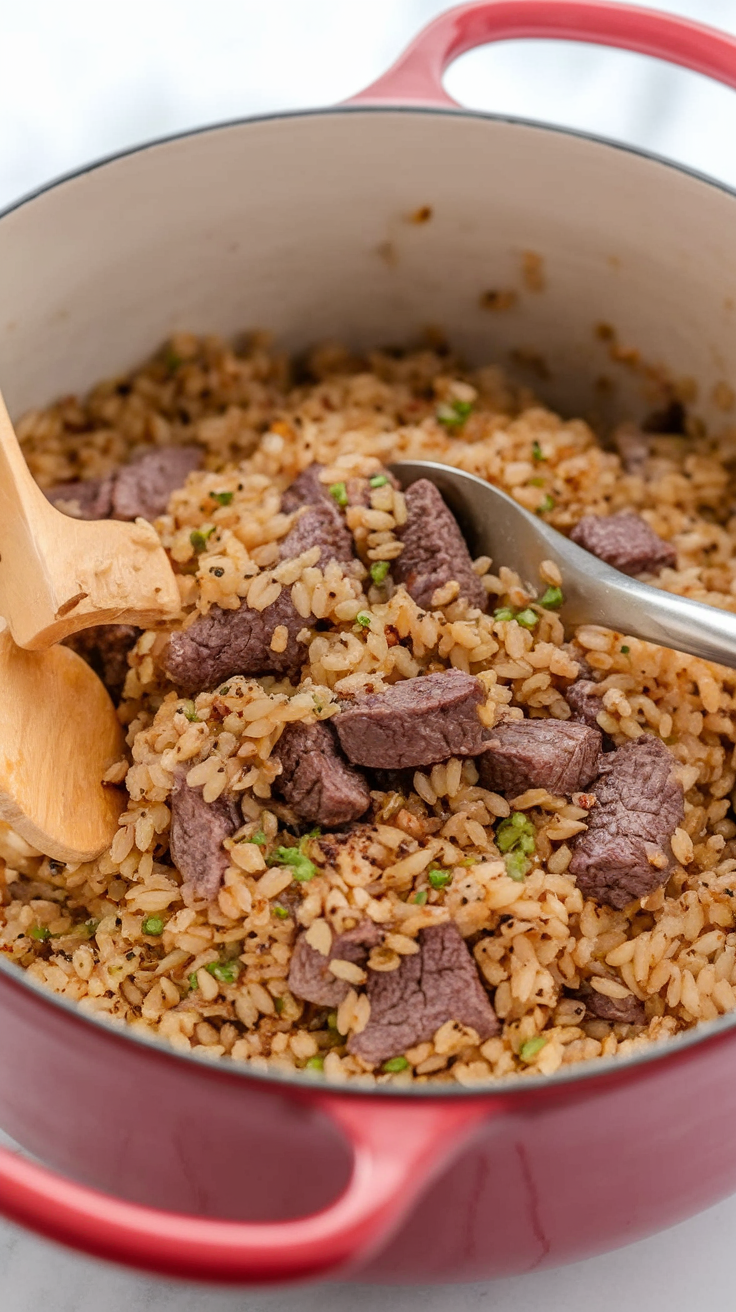When I think of comfort food, my mind often wanders to the rich, aromatic scents wafting from a pot of beef plov. It’s like a warm hug on a chilly evening, the kind that makes you reminisce about family dinners or cozy nights in. Plus, who can resist the way the tender beef and seasoned rice dance together on the taste buds?
Steps
- Heat a large pot or Dutch oven on medium-high and add olive oil and half the butter. Cook the diced onion until it’s soft, stirring occasionally for around 5 minutes.
- Add the beef cubes to the pot, sautéing them for 5 minutes and turning once. Incorporate the julienned carrots and stir everything together for another minute.
- Pour in cold water and season with cumin, salt, and pepper. Bring the mixture to a boil, then reduce to a low simmer, cover, and cook for 1 hour.
- About 10 minutes before the beef is done, melt the remaining butter in a skillet over medium-high heat. Toast the buckwheat groats until golden, stirring frequently for about 3-5 minutes, then transfer to the pot and cover with hot water.
- Slice the garlic head in half and position it cut-side down on top of the buckwheat. Cook uncovered over medium heat until most of the water evaporates, roughly 10 minutes.
- Poke several holes through the buckwheat to let steam escape, cover the pot, and set the heat to the lowest setting. Let it sit for another 30 minutes, then remove the garlic, gently mix everything, and serve. Optionally, squeeze the garlic cloves out of their skins and mix them into the pilaf.
Ingredients
- 1/3 cup olive oil
- 8 tablespoons unsalted butter, separated
- 1 large onion, chopped
- 1 to 1 1/4 pounds beef (such as chuck, sirloin, or quality stew meat), trimmed of excess fat and cut into 1/2 to 3/4 inch pieces
- 3 large carrots, cut into julienne strips
- 2.5 cups buckwheat groats (also known as grechka)
- 4 1/4 cups cold filtered water plus 1 cup hot water
- 2 teaspoons salt and 1/4 teaspoon black pepper, or to taste (preferably sea salt)
- 1 teaspoon ground cumin, or to taste
- 1 whole head of garlic, unpeeled
FAQ
- What type of beef is best for Buckwheat and Beef Pilaf?
- You can use various cuts of beef for this recipe, but it’s ideal to choose one with some marbling or fat for optimal flavor. A chuck roast is a good choice, as it becomes tender and flavorful when cooked.
- Can I substitute buckwheat with another grain in this pilaf?
- While this recipe specifically highlights buckwheat for its unique flavor and nutritional benefits, you could experiment with other grains like quinoa or barley. However, these substitutions will alter the texture and taste of the dish.
- How should the garlic be prepared for this dish?
- The recipe calls for a whole head of unpeeled garlic to be cut in half and placed cut-side down on top of the buckwheat. As the dish cooks, the garlic softens and can be squeezed out of its skins and mixed into the pilaf if desired.
- Is it necessary to toast the buckwheat before adding it to the dish?
- Yes, toasting the buckwheat is a crucial step as it enhances the nutty flavor and prevents it from becoming mushy during cooking. Toast the buckwheat until golden brown before adding it to the pot.
- What can I serve with Buckwheat and Beef Pilaf?
- This hearty pilaf pairs well with pickles, adding a tangy contrast to the rich flavors of the dish. You might also consider serving it with a fresh salad or yogurt-based sauce to complement the meal.
Tips
- Opt for beef cuts with some marbling or fat, such as chuck or sirloin, to ensure the meat remains tender and flavorful during cooking.
- When toasting the buckwheat, stir frequently to achieve a uniform golden color, which enhances the nutty flavor of the dish.
- Carefully slice the garlic head in half and position it cut-side down on the buckwheat for a subtle infusion of garlic flavor throughout the pilaf.
- Before the final simmer, create small holes in the buckwheat to allow steam to escape, which helps in evenly cooking the grains and enhancing the overall texture.
Equipment
- Large heavy-bottomed stock pot or Dutch oven (at least 5 1/2 Qt)
- Large non-stick skillet
- Julienne slicer (for the carrots)


